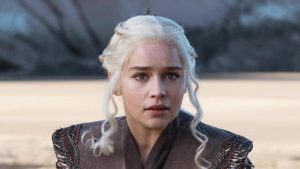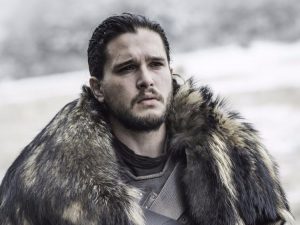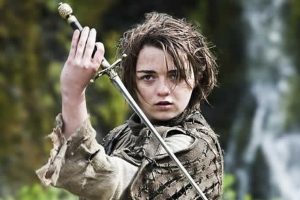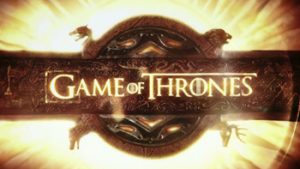 By Scott T. Allison
By Scott T. Allison
Since the advent of language, human beings have been magnetically drawn to tales of inspiring heroes. The powerful allure of heroism is wired into us, and science appears to support that claim. Hero stories fascinate us because we are all potential heroes, and we’re called to follow the same heroic journey as the protagonists in the stories we love.
Game of Thrones, one of the most highly acclaimed series in television history, owes much of its success to its effective portrayal of heroes. There are at least five deep hero archetypes that Game of Thrones uses to create alluring heroes. These archetypes are: (1) the underdog hero, (2) the hero’s secret royal heritage, (3) the hero’s redemption, (4) the heroic transformation, and (5) the hero’s mentor.
1. The Underdog Hero. There are over a half-dozen characters in the series that win our hearts because of their ability to overcome their underdog status. Tyrion Lannister is a dwarf whom everyone seems to underestimate. He uses his wit, intelligence, and wisdom to survive and thrive in Game of Thrones’ harsh world. Jon Snow is the bastard child of Ned Stark, a status that relegates him to third-class citizenship, yet his overall goodness and courage allow him to climb the social ladder.
Two legitimate Stark children, Sansa and Arya, are diminished and underestimated due to the lowly status of women in Westeros, yet their resilience and cunning enable them to overcome evil. Samwell Tarly is at first a  lovable coward whom everyone dismisses but he evolves into a brave and stalwart member of the night’s watch. Daenerys Targaryen is, at the outset of Game of Thrones, mere breeding stock for the Dothrakis yet she emerges as the most powerful ruler of the seven kingdoms.
lovable coward whom everyone dismisses but he evolves into a brave and stalwart member of the night’s watch. Daenerys Targaryen is, at the outset of Game of Thrones, mere breeding stock for the Dothrakis yet she emerges as the most powerful ruler of the seven kingdoms.
2. The Hero’s Secret Royal Heritage. In many classic fairy tales, the hero is oblivious to their true special identity, which is often that of a king, queen, prince, or princess. Jon Snow suffers the status of an outcast, and unbeknownst to everyone he is actually the true heir to the iron throne.
As mentioned, Daenerys at first is nothing more than a sex slave while her true identity is Queen of the Andals, the Rhoynar and the First Men, Protector of the Realm, Queen of Meereen, Yunkai and Astapor, Khaleesi of the Great Grass Sea, Mother of Dragons, The Unburnt Breaker of Chains, Lady of Dragonstone, and more.
Bran Stark has been reduced to a crippled boy but soon discovers his true identity as the three-eyed raven who can see the past, present, and future. It should be noted that the “third eye” is considered a sign of deep enlightenment in Christian, Hindu, and Buddhist cultures. Bran grows from nothingness into omniscience.
3. The Redeemed Hero. Stories of redemption abound in Game of Thrones. One notable redeemed hero is Theon Greyjoy, an arrogant jerk who develops severe PTSD after enduring lengthy mental and physical torture at the hands of Ramsey Bolton. Humbled almost beyond repair, Greyjoy slowly regains his confidence and appears to be climbing to the status of a leader as the series enters its final season.
Jaime Lannister’s redemption looked next to impossible after he shoved young Bran Stark to his seeming doom in the series’ first episode. Seemingly irredeemable, Jaime has proven himself to be one of the more loyal and honorable Lannisters. In fact, he could be the only person willing and able to stop his evil sister Cersei. The Hound, who was once a vicious killer, is another character who appears to be slowly carving out a redemptive heroic path for himself.
 4. Heroic Transformation. During their journeys, heroes undergo significant mental, moral, emotional, spiritual, and physical transformations. The two Stark sisters, Arya and Sansa, each undergo transformative arcs. Sansa grows in confidence and wisdom, whereas Arya grows into a fierce and daring swordsperson. Jon Snow, too, evolves from a mere guardian of the wall into a wise king of the north. Bran, of course, undergoes a striking spiritual transformation.
4. Heroic Transformation. During their journeys, heroes undergo significant mental, moral, emotional, spiritual, and physical transformations. The two Stark sisters, Arya and Sansa, each undergo transformative arcs. Sansa grows in confidence and wisdom, whereas Arya grows into a fierce and daring swordsperson. Jon Snow, too, evolves from a mere guardian of the wall into a wise king of the north. Bran, of course, undergoes a striking spiritual transformation.
Theon Greyjoy transforms twice, first from an arrogant lord into an emotionally destroyed cipher, and then from that cipher into a newly empowered lord. Daenerys owes her remarkable transformation to an unnamed servant to Drogo, a woman who teaches the future Queen how to empower herself in her marriage. This act of mentorship sends Daenerys on her heroic journey.
5. The Hero’s Mentor. In classic hero mythology, heroes receive assistance for someone older, wiser, or unusual in some respect. Daenerys has had several mentors giving her advice over the years, the two most prominent being Jorah Mormont and Tyrion Lannister. Jon Snow was mentored by Ned Stark, Davos Seaworth, and Maester Aemon. Snow himself has served as a mentor to Samwell and to Theon.
There have been plenty of dark mentors, too — people who appear to mean well but are intent on steering the hero down a dark path. Sansa Stark’s dark mentor is Petyr ‘Littlefinger’ Baelish, who manipulates her into making several bad decisions. King Tommen’s dark mentor is the High Sparrow who steers Tommen toward betraying his wife and his mother. Some mentors are a mix of good and bad, as when Arya Stark is trained by the assassin Jaquen H’ghar, the mysterious man of many faces who teaches Arya important skills yet almost destroys her in the process.
– – – – – – – –
Game of Thrones has won 39 Emmy Awards for a reason – the series has crafted highly memorable characters who have undergone dramatic heroic arcs. We’ve reviewed five ways that Game of Thrones has used powerful hero archetypes in portraying extraordinary heroism. We look forward to the series’ eighth and final season when all these hero journeys reach their natural completion.

I am interested in discussing our need for a comprehensive Western Feminine Archetype. I am making the assumption it is beyond a heroine journey but more an energy that can guide as a unifying set of values and has its power is mostly in the collective unconscious.
Would you be willing to engage in a dialogue with me on this topic?